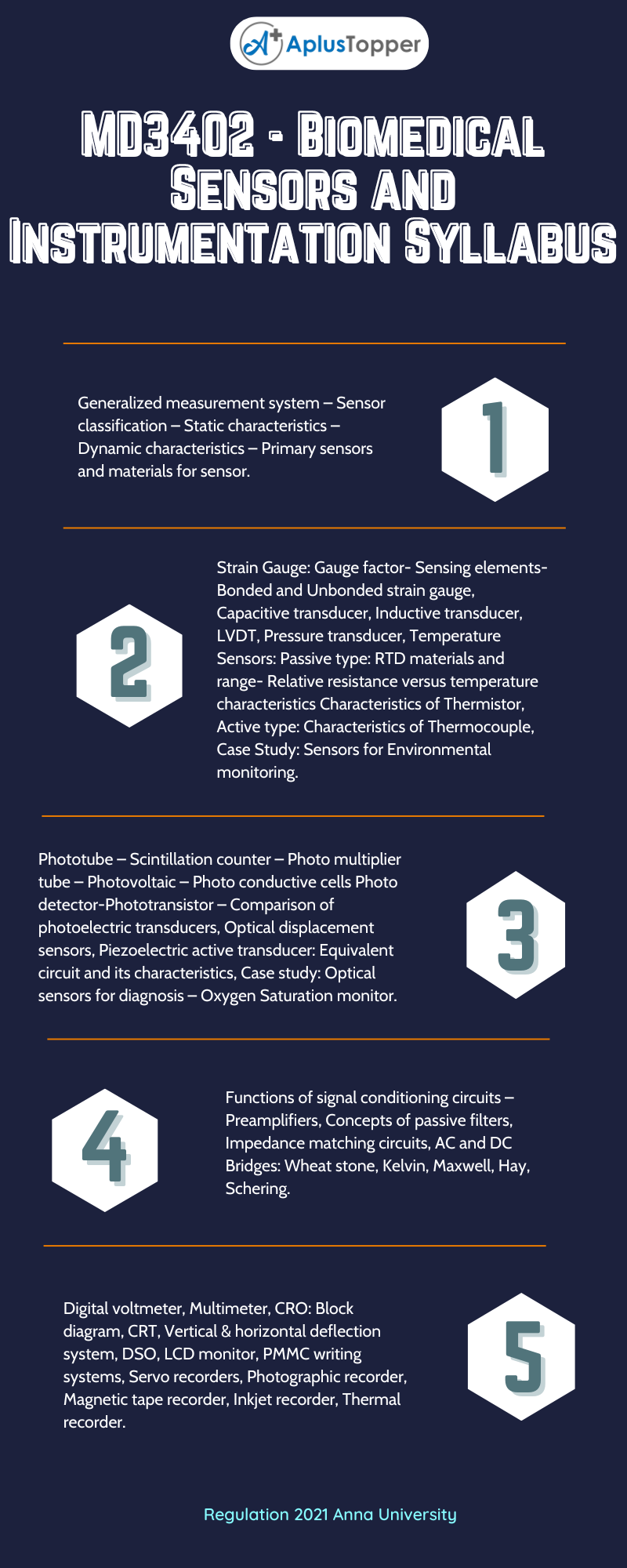Biomedical Sensors and Instrumentation syllabus regulation 2021 of Anna University B.E Medical Electronics. In this article, we would like to provide the semester IV of the B.E Medical Electronics Engineering Syllabus.
We would like to discuss the detailed syllabus of the Subject code MD3402 – Biomedical Sensors and Instrumentation. You can easily note down and take notes according to the syllabus. We add a unit-wise syllabus to this page. Along with that, we included the required textbooks and references from the expert faculty. You can also prepare for exams with a clear picture of the syllabus. The following unit-wise syllabus will assist you well. I hope this information is useful. Never forget to share it with your friends.
If you want to know more about the B.E Medical Electronics Engineering syllabus connected to an affiliated institution’s four-year undergraduate degree program. We provide you with a detailed Year-wise, semester-wise, and Subject-wise syllabus in the following link B.E Medical Electronics Engineering Syllabus Regulation 2021 Anna University.
Aim Of Objectives:
- To understand the purpose of measurements and characteristics.
- To know the principle of transduction, classification and the characteristics of transducers.
- To know the different bridges for measurement.
- To know the different display and recording devices.
MD3402 – Biomedical Sensors and Instrumentation Syllabus
Unit – I: Sensor-Based Measurement System
Generalized measurement system – Sensor classification – Static characteristics – Dynamic characteristics – Primary sensors and materials for sensor.
Unit – II: Displacement, Pressure And Temperature Sensors
Strain Gauge: Gauge factor- Sensing elements- Bonded and Unbonded strain gauge, Capacitive transducer, Inductive transducer, LVDT, Pressure transducer, Temperature Sensors: Passive type: RTD materials and range- Relative resistance versus temperature characteristics Characteristics of Thermistor, Active type: Characteristics of Thermocouple, Case Study: Sensors for Environmental monitoring.
Unit – III: Photoelectric And Piezo Electric Sensors
Phototube – Scintillation counter – Photo multiplier tube – Photovoltaic – Photo conductive cells Photo detector-Phototransistor – Comparison of photoelectric transducers, Optical displacement sensors, Piezoelectric active transducer: Equivalent circuit and its characteristics, Case study: Optical sensors for diagnosis – Oxygen Saturation monitor.

Unit – IV: Signal Conditioning Circuits
Functions of signal conditioning circuits – Preamplifiers, Concepts of passive filters, Impedance matching circuits, AC and DC Bridges: Wheat stone, Kelvin, Maxwell, Hay, Schering.
Unit – V: Display And Recording Devices
Digital voltmeter, Multimeter, CRO: Block diagram, CRT, Vertical & horizontal deflection system, DSO, LCD monitor, PMMC writing systems, Servo recorders, Photographic recorder, Magnetic tape recorder, Inkjet recorder, Thermal recorder.
Text Books:
- A.K.Sawhney, “Electrical & Electronics Measurement and Instrumentation”, Dhanpat Rai & Co, New Delhi, 2017.
- John G. Webster, “Medical Instrumentation Application and Design”, Wiley India Pvt Ltd, New Delhi, 2020.
References:
- Leslie Cromwell, “Biomedical Instrumentation and Measurement”, Prentice Hall of India, New Delhi, 2015.
- Albert D. Helfrick, William D. Cooper, “Modern Electronic Instrumentation and Measurement Techniques”, Prentice Hall of India, New Delhi, 2016.
- KhandpurR.S, “Handbook of Biomedical Instrumentation”, Tata McGraw-Hill, New Delhi, 2014.
- BanshiDhar Gupta, Anand Mohan Shrivastav and SruthiPrasood Usha, “Optical Sensors for Biomedical Diagnostics and Environmental Monitoring”, CRC Press, New York, 2018.
Related Posts On Semester – IV:
- MA3355 Random Processes and Linear Algebra
- MD3401 Analog and Digital Electronics
- BM3451 BioControl Systems
- EC3492 Digital Signal Processing
- GE3451 Environmental Sciences and Sustainability
Also Check:
